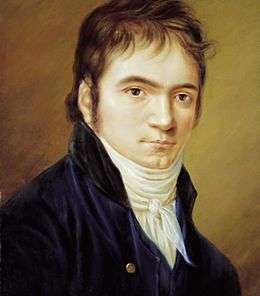String Quartet No. 10 (Beethoven)
Ludwig van Beethoven's String Quartet No. 10 in E-flat major, Op. 74, was written in 1809 and is nicknamed the "Harp" quartet.
| String Quartet | |
|---|---|
| No. 10 | |
| by Ludwig van Beethoven | |
 Ludwig van Beethoven, 1803 portrait | |
| Key | E-flat major |
| Opus | Op. 74 |
| Composed | 1809 |
| Movements | Four |
The nickname "Harp" refers to the characteristic pizzicato sections in the allegro of the first movement, where pairs of members of the quartet alternate notes in an arpeggio, reminiscent of the plucking of a harp. Like many nicknames for Beethoven's works, this was created by the publisher.
Movements
I. Poco adagio – Allegro
The first movement is in sonata form.
- Slow introduction – Poco adagio (mm. 1–24)
- Exposition – Allegro (mm. 25–77)
- 1st tonal area, E♭ major (mm. 25–51)
- Pizzicati lead transition to tonal area 2
- 2nd tonal area, B♭ major (mm. 52–69)
- Closing (mm. 70–77)
- Development (mm. 78–139)
- Recapitulation (mm. 140–205)
- Coda (mm. 206–262)
II. Adagio ma non troppo
The second movement is in rondo form.
III. Presto
The third movement is a scherzo.
- Scherzo, C minor (mm. 1–76)
- Trio, C major (mm. 77–169)
- Scherzo (mm. 170–245)
- Trio (mm. 246–338)
- Scherzo (mm. 339–467)
IV. Allegretto con variazioni
The fourth movement is a set of ornamental variations on a theme in E♭ major. Its coda begins at m. 142.
Analysis
The first movement, of about ten minutes duration, is one of the best examples of Beethoven's management of musical tension. The short adagio introduction (24 bars long) is not tightly thematically integrated with the rest of the movement; it serves a similar function to the introduzione of the first movement of Op 59, No 3. The main motifs of the allegro are the lyrical melody appearing several bars from the beginning, and the pizzicato arpeggios played by two instruments accompanied by repeating quavers played by the other two. At first, these two themes appear thematically and rhythmically unrelated. It is only the last fifty bars that the listener discovers that Beethoven's true purpose is for them to be played simultaneously, beneath a frenetic violin part, to generate the climax of the movement.
The Harp quartet parallels many facets of the Fifth Symphony. The heroic quality pervading Beethoven's middle period is heard extensively in the first movement. Both the Fifth Symphony and Harp quartet have intense scherzi. Nevertheless, the grand entrance to the opening of the finale of the Fifth is noticeably absent in the opening of Op. 74. The fourth movement of the Harp quartet follows a highly traditional theme and variations form. The Classical style of the fourth movement juxtaposed against the Heroic nature of the first movement frustrates Beethoven scholars who seek to contextualize this piece in Beethoven's stylistic trajectory.
Further reading
- Kerman, Joseph, The Beethoven Quartets. New York, W.W. Norton & Co., 1966, pp. 155–168 ISBN 0-393-00909-2
- Marliave, Joseph de., trans. Hilda Andrews. Beethoven's Quartets New York: Dover, 1961, pp. 146–173.
- Marston, Nicholas. "Analysing Variations: The Finale of Beethoven's String Quartet Op. 74." from Music Analysis 8, no.3 (October 1989): pp. 303–324.
- Radcliffe, Philip. Beethoven's String Quartets New York: E.P. Dutton, 1968, pp. 82–89.
- Shepherd, Arthur. The String Quartets of Ludwig Van Beethoven. Cleveland: The Printing Press, 1935, pp. 37–39.
- Thakar, Markand. Looking for the 'Harp' Quartet: An Investigation into Musical Beauty. University of Rochester Press, 2011.
- Robert Winter and Robert Martin, eds. The Beethoven Quartet Companion. Berkeley, CA: University of California Press, 1994, pp. 196–203.
External links
- String Quartet No. 10: Scores at the International Music Score Library Project (IMSLP)
- Performance of String Quartet No. 10 by the Borromeo String Quartet from the Isabella Stewart Gardner Museum in MP3 format